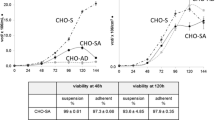Abstract
The effects of constant osmolarity, between 300 and500 mOsm/kg, on the metabolism of Chinese HamsterOvary (CHO) cells producing tissue plasminogenactivator (tPA) were compared between adhesion andsuspension cultures. In both suspension and adhesionculture, the specific rates of glucose consumption(νG), lactate production (qL), and tPAproduction (qtPA) increased as osmolarityincreased, while these rates decreased when osmolaritywas higher than the respective critical levels. However, specific growth rate (μ) decreased withincrease in osmolarity and this slope grew steeper inthe osmolarity range higher than the critical level. The decrease in μ in the adhesion culture was morerapid than that in the suspension culture. Thecritical osmolarity for adhesion culture (400 mOsm/kg)was lower than that for suspension culture (450 mOsm/kg). These results indicated that the adhesionculture was more sensitive to increase of osmolaritythan the suspension culture, while the specific ratesobtained from the adhesion cultures were in general1.5- to 3-fold higher than those obtained from thesuspension cultures. Cell volume increased asosmolarity increased in both the suspension andadhesion cultures, as reported previously forsuspension culture of hybridoma cells, but there wasno morphological change in the suspension culture. Incontrast, cell height decreased and cell adhesion areamarkedly increased as osmolarity increased in theadhesion culture. This morphological change inadhesion cultures may be one reason for the highersensitivity of adherent cells to the increase ofosmolarity than suspended cells.
Similar content being viewed by others
References
Butt HJ, Wolff EK, Gould SA, Dixon NB, Peterson CM & Hansma PK (1990) Imaging cells with the atomic force microscope. J Struct Biol 105: 54-61.
Fernandez E, Vicente A, Zapata A, Brera B, Lozano JJ, Martinez C & Toribio ML (1994) Establishment and characterization of cloned human thymic epithelial cell lines. Analysis of adhesion molecule expression and cytokine production. Blood 83: 3245-3254.
Hardin JA, Yamaguchi K & Sherr DH (1995) The role of peritoneal stromal cells in the survival of slgM+ peritoneal B lymphocyte population. Cell Immunol 161: 50-60.
Hooker AD, Goldman MH, Markham NH, James DC, Ison AP, Bull AT, Strange PG, Salmon I, Baines AJ & Jenkins N (1995) Nglycans of recombinant human interferon-change during batch culture of Chinese hamster ovary cells. Biotech Bioeng 48: 639-648.
Tong JZ, Bernard O & Alvarez F (1990) Long-term culture of rat liver cell spheroids in hormonally defined media. Exp Cell Res 189: 87-92.
Tsuji T, Ogasawara H, Aoki Y, Tsurumaki Y & Kodama H (1996) Characterization of murine stromal cell clones established from bone marrow and spleen. Leukemia 10: 803-812.
Oh SKW, Chua FKF & Choo ABH (1995) Intracellular responses of productive hybridomas subjected to high osmolarity. Biotech Bioeng 46: 525-535.
Oyaas K, Ellingsen TE, Dyrset N & Levine DW (1994) Utilization of osmoprotective compounds by hybridoma cells exposed to hyperosmotic stress. Biotech Bioeng 43: 77-89.
Oyaas K, Ellingsen TE, Dyrset N & Levine DW (1994) Hyper osmotic hybridoma cell culture: Increased monoclonal antibody production with addition of glycine betaine. Biotech Bioeng 44: 991-998.
Ozturk SS & Palsson BO (1991) Effect of medium osmolarity on hybridoma growth, metabolism, and antibody production. Biotech Bioeng 37: 989-993.
Reusch HP, Lowe J & Ives HE (1995) Osmotic activation of a Na+-dependent Cl–/HCO3 – exchanger. Am J Physiol 268: C147-C153.
Sanford KK, Earle WR, Evans VJ, Waltz HK & Shannon JE (1950) The measurement of proliferation in tissue cultures by enumeration of cell nuclei. J Nat Canc Inst 11: 773-795.
Author information
Authors and Affiliations
Corresponding author
Rights and permissions
About this article
Cite this article
Takagi, M., Hayashi, H. & Yoshida, T. The effect of osmolarity on metabolism and morphology in adhesion and suspension chinese hamster ovary cells producing tissue plasminogen activator. Cytotechnology 32, 171–179 (2000). https://doi.org/10.1023/A:1008171921282
Issue Date:
DOI: https://doi.org/10.1023/A:1008171921282




